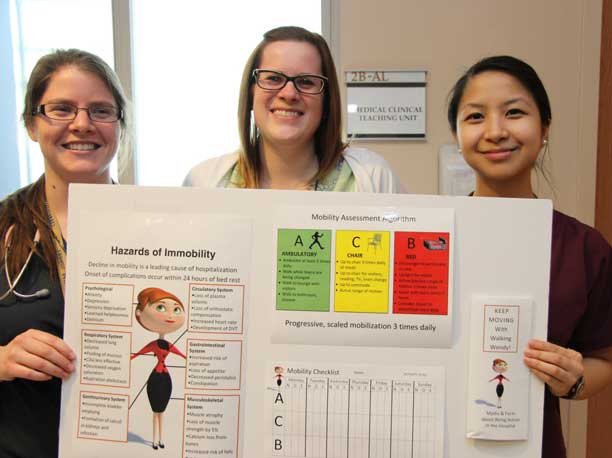

THUNDER BAY – Health – Although many people believe rest is best during a hospital stay, mobility actually plays a far greater role in recovery.
“A lot of patients, especially those 65 and over, feel that when they’re in hospital, they should stay in bed and rest,” says Terry Robertshaw, Nurse Practitioner at Thunder Bay Regional Health Sciences Centre (TBRHSC).
Move On – Mobility a key to recovery
But 65-plus patients are at a much greater risk of declining health and reduced independence if they don’t keep moving while in hospital: older adults lose 1 to 5% of muscle strength each day in hospital and many of those are unable to recover function after they are discharged.
There is some good news. Research shows that when members of the healthcare team get patients moving while they are hospitalized, many of these risks for patients can be avoided. Staying mobile also decreases both length of stay and the risk of depression and increases the numbers of patients discharged to home.
Working collaboratively with 14 other members of the Council of Academic Hospitals of Ontario (CAHO), TBRHSC is participating in MOVE ON – Mobilization of Vulnerable Elders in Ontario – a project that aims to implement and evaluate an evidence-based strategy to promote mobilization and prevent decline in older hospital patients. So far, the project has been implemented in the 2B Medical Unit.
A baseline audit was first conducted to determine how often patients are mobilized as the main objective of this provincial project is to increase how often patients are up and about while they are in the hospital.
What does this mean for patients? “It is a matter of planned mobility specific to each patient,” says Jennifer Hawley, MOVE ON Project Lead at TBRHSC. “After the patient’s mobility level is identified, we work with the patient, the family and the healthcare team to make a plan to see what we can do to maintain and even increase mobility for the patient. Teaching and communicating with the patient and family are key.”
Family members can help by encouraging their loved one to keep moving and doing as much as they can independently. They can also help by bringing in the patient’s mobility aids, such as a walker, non-skid slippers, cane, and glasses.
Even though the research clearly shows that mobility improves a patient’s mood, sleep, breathing, circulation, appetite and ability to fight infection, some patients are still not persuaded. “The concept that rest is not necessarily the best thing is a culture change, especially for our older population,” says Hawley. Fear of falling is another concern for older patients, especially if they have already fallen once.
Depending on the patient, mobility could mean walking, either alone or with assistance, or, for others who are unable to walk, it might mean doing bed exercises on their own throughout the day, sitting up in a chair when there are visitors, and sitting in a chair or sitting up in bed to eat.
Hawley says encouraging patients to keep moving is something staff from the 2B unit were already doing but participating in the MOVE ON project has helped to reinforce that commitment. Posters and other printed materials that feature the project mascot “Wendy” outline the risks of immobility and suggest several activities for patients.
“We really can’t stress enough how important mobility is for older hospital patients,” says Hawley. “If they were living independently at home and they come into hospital, they need to keep mobile in order to maintain their independence when they return home.”





